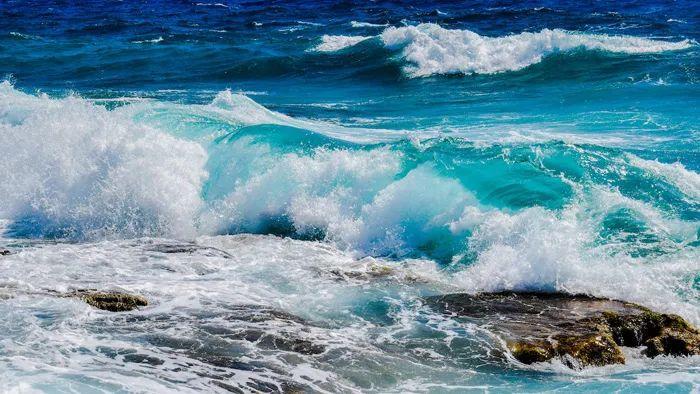海的颜色在变化?研究:气候变化让海洋变得更绿
研究发现,全球的海洋颜色在过去20年来发生了显著改变,尤其是赤道附近的热带海洋变得更绿了。科学家指出,这是由人为导致的气候变化引起的。

Thecoloroftheoceanhaschangedsignificantlyoverthelast20yearsandhuman-causedclimatechangeislikelyresponsible,accordingtoanewstudy.
一项新研究发现,海水颜色在过去20年发生了显著改变,很可能是受到了人为导致的气候变化的影响。
Morethan56%oftheworld’soceanshavechangedcolortoanextentthatcannotbeexplainedbynaturalvariability,saidateamofresearchers,ledbyscientistsfromtheNationalOceanographyCenterintheUKandtheMassachusettsInstituteofTechnologyintheUS,inastatement.
英国国家海洋中心和美国麻省理工学院的科学家带领的研究团队称,全世界超56%的海水颜色发生了改变,这一变化无法用自然变异来解释。
Tropicaloceansclosetotheequatorinparticularhavebecomegreenerinthepasttwodecades,reflectingchangesintheirecosystems,accordingtothestudypublishedWednesdayinthejournal Nature.
7月12日发表在《自然》期刊上的这篇研究报告指出,特别是靠近赤道的热带海洋在过去20年来变得更绿了,反映出这些海域生态系统的改变。
Thecoloroftheoceanisderivedfromthematerialsfoundinitsupperlayers.Forexample,adeepblueseawillhaveverylittlelifeinit,whereasagreencolormeansthereareecosystemsthere,basedonphytoplankton,plant-likemicrobeswhichcontainchlorophyll.Thephytoplanktonformthebasisofafoodwebwhichsupportslargerorganismssuchaskrill,fish,seabirdsandmarinemammals.
海洋颜色源于海洋上层的物质。举例而言,深蓝色的海洋上层存在的生物很少,而绿色的海洋意味着有基于浮游植物的生态系统的存在。浮游植物是含有叶绿素的类似植物的微生物。浮游植物构成了食物网的基础,食物网支持较大的生物,比如磷虾、鱼类、海鸟和海洋哺乳动物。
It’snotclearexactlyhowtheseecosystemsarechanging,saidstudyco-authorStephanieDutkiewicz,seniorresearchscientistinMIT’sDepartmentofEarth,AtmosphericandPlanetarySciencesandtheCenterforGlobalChangeScience.
研究报告的合著者、麻省理工学院地球、大气与行星科学系和全球变化科学中心的高级研究科学家斯蒂芬妮·杜特科维奇表示,目前尚不清楚这些生态系统产生了怎样的变化。
Oceanecosystemsarefinelybalancedandanychangeinthephytoplanktonwillsendripplesacrossthefoodchain.“Allchangesarecausinganimbalanceinthenaturalorganizationofecosystems.Suchimbalancewillonlygetworseovertimeifouroceanskeepheating,”shetoldCNN.
她告诉美国有线电视新闻网,海洋生态系统处于微妙的平衡状态,浮游植物的任何变化都会在整个食物链中产生连锁反应。“所有的变化都会导致生态系统的自然组织失去平衡。如果我们的海洋继续变暖,这种不平衡随着时间的推移只会变得更糟。”
Itwillalsoaffecttheocean’sabilitytoactasastoreofcarbon,Dutkiewiczsaid,asdifferentplanktonabsorbdifferentamountsofcarbon.
杜特科维奇称,这也会影响海洋储存碳的能力,因为浮游生物的碳吸收量各有不同。
Whiletheresearchersarestillworkingtounpickexactlywhatthechangesmean,whatisclear,theysaid,isthatthechangesarebeingdrivenbyhuman-inducedclimatechange.
尽管研究人员仍致力于解开海洋颜色变化之谜,但是他们指出,有一点是确定无疑的,那就是海洋颜色的改变是由人为导致的气候变化引起的。
Theresearchersmonitoredchangesinoceancolorfromspacebytrackinghowmuchgreenorbluelightisreflectedfromthesurfaceofthesea.
研究人员通过空间站跟踪记录从海面反射的绿光或蓝光量来监测海洋颜色的变化。
Theyanalyzedcolorvariationdatafrom2002to2022andthenusedclimatechangemodelstosimulatewhatwouldhappentotheoceansbothwithadditionalplanet-heatingpollutionandwithout.
他们分析了2002年至2022年的海洋颜色变化数据,然后使用气候变化模型来模拟海洋在有温室气体污染和没有污染的情况下会发生什么。
ThecolorchangesmatchedalmostexactlywhatDutkiewiczpredictedwouldhappenifgreenhousegaseswereaddedtotheatmosphere–thataround50%ofouroceanswouldchangecolor.
结果,海洋颜色变化几乎与杜特科维奇预测的完全一致,当大气中加入温室气体时,大约50%的海洋会改变颜色。
编辑:丹妮
来源:美国有线电视新闻网
